Melatonin & Immune Function: What the science tells us?
Was suggested in a publication on March 16th 2020 in the journal Cell Discovery by Cleveland Clinic researchers, who hit on the hormone after analyzing the genomes of 15 human "this" infection. The team compared "this" infection with the coronavirus that caused "this" infection outbreak of 2003 using a technique called “network proximity analysis” to identify combinations of existing drugs that may be able to target cellular factors that allow the "v." or vyrus to replicate. They concluded that mercaptopurine plus melatonin might be a powerful combination against "this" infection. Ref.
Melatonin? Stem cells? Researchers step up with unconventional approaches to "this" infection Ref
"The efficiency of Melatonin in protecting from lethal v. infections warrants further investigations!" Crossref
"Administration of Melatonin after v. inoculation reduced v. mia and significantly postponed the onset of disease and death by 7 to 10 days. Moreover Melatonin reduced mortality of Semliki Forest v. (SFV) inoculated mice from 100% to 44%!" Crossref
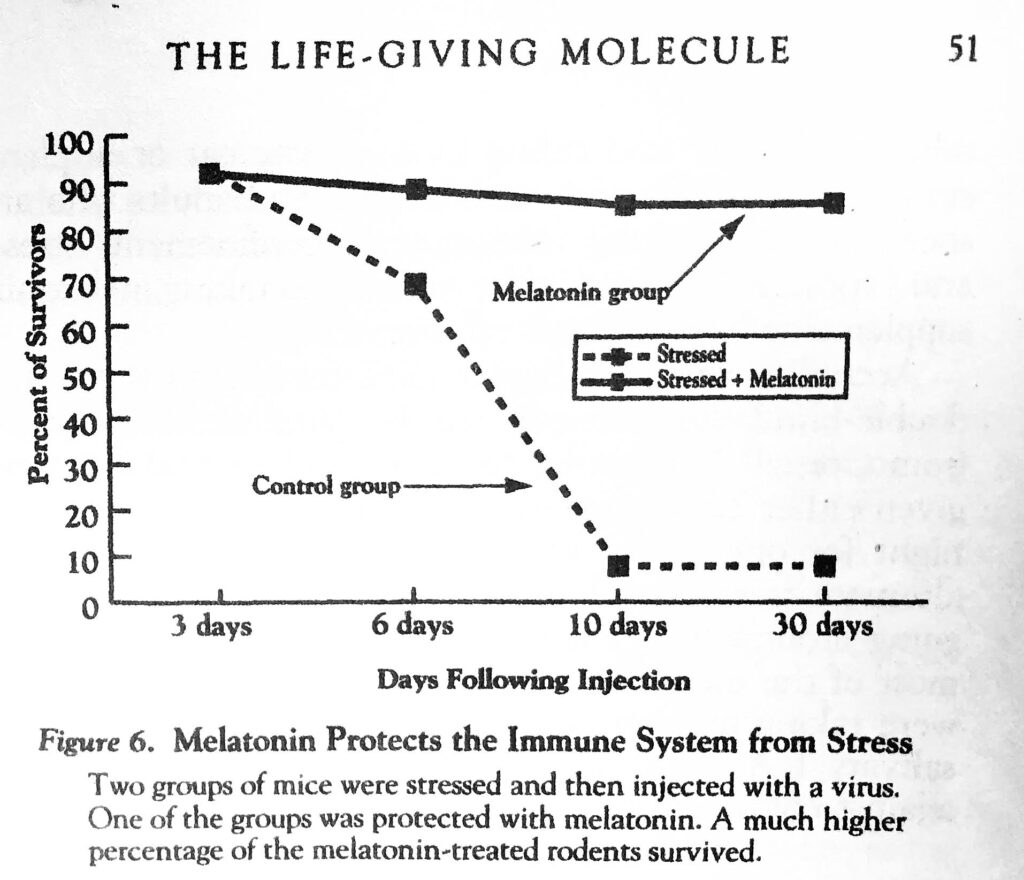
FREE WEBINAR
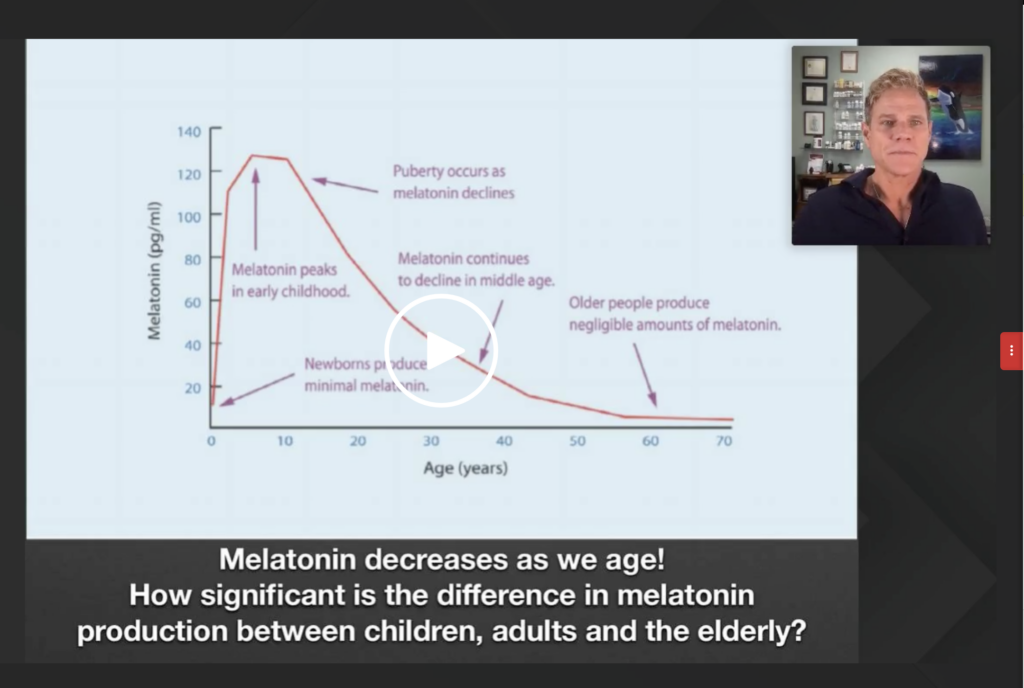
Registar here.
Ebola V. & Melatonin
EBOLA activates the coagulation system and has a considerable disruption to the vascular endothelium. Melatonin seems to act on damaging blood vessel alterations caused by the Ebola v.
Effects of melatonin on vascular permeability and integrity under oxidative stress. Melatonin prevents the increased permeability of the capillaries induced by ischemia/reperfusion and the vessels appear intact and capillary perfusion is preserved. Ref.
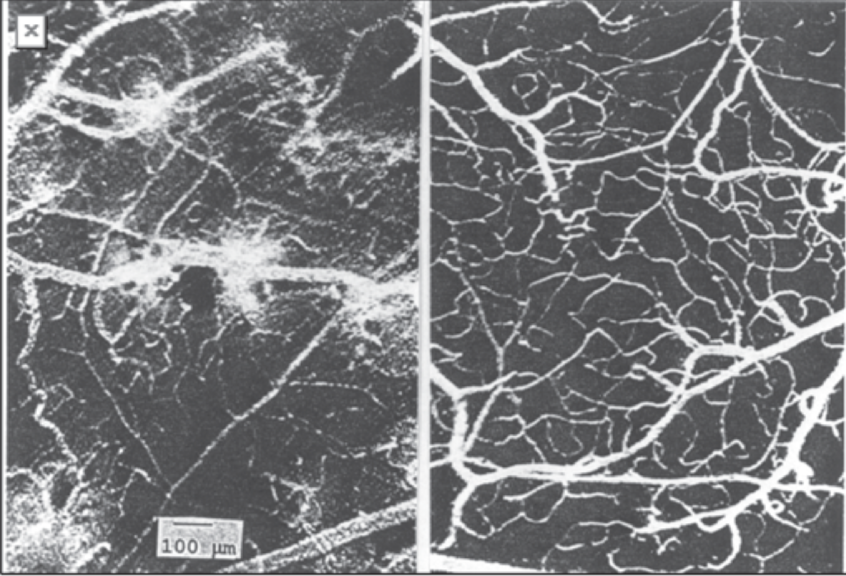
Above: On the left is what Ebola v. does to the blood vessels with out melatonin administered. The right shows how melatonin preserves the endothelial cells from the damaging effects of the v.!
Looking at our current infection Pandemic lest consider why infants and children under the age of nine do not seem to suffer any severe symptoms with this infection. It is understandable why older patients may be more susceptible to higher risks, but what spares young children? Why are young adults without comorbidities also suffering from pneumonia as a result of "this" infection infections?
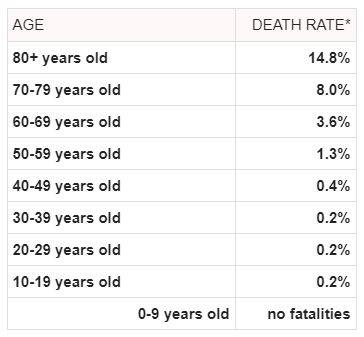
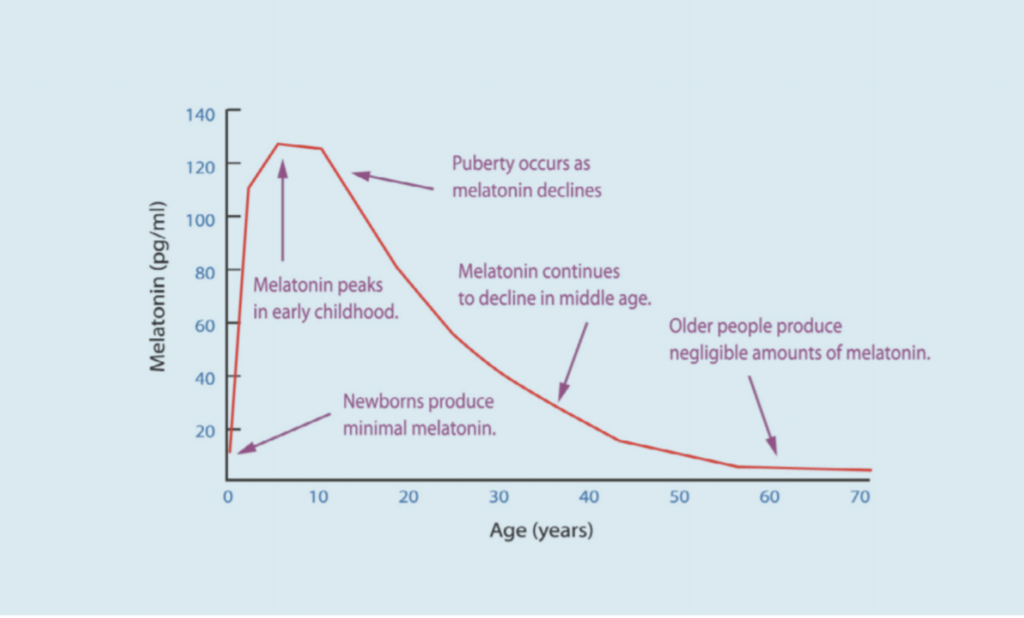
"Melatonin is the reason why children under the age of 9 seldom exhibit severe symptoms. In fact, children may exhibit mild or even no symptoms at all, even though they have been infected by "this" infection Ref. "How significant is the difference in melatonin production between children, adults and the elderly?
Melatonin Inhibits something called " Inflammasomes" Melatonin is well known for its regulating biological functions tied to circadian rhythms/ Sleep Wake Cycles. Numerous studies have revealed that melatonin exerts effects beyond just helping us sleep. This infection specifically triggers the activation of something called NLRP3 inflammasomes, resulting in the overproduction of pro-inflammatory IL-1β cytokines. Ref This is what leads to the sever ARDS (sever lung disease) and death. This inflammasome is now recognized as a target for melatonin which calms this down! Ref
Since pro-inflammatory cytokine storm effects are induced by the activation of NLRP3 inflammasomes, the ability of melatonin to calm NLRP3 inflammasome elevates this powerful molecule to a truly unique position in the fight against This infection. This also means that if a patient, regardless of age, has adequate melatonin, the infectiousness of This infection will be greatly reduced, and the chances of developing ARDS is significantly diminished. Ref
Melatonin is the reason why children under the age of 9 seldom exhibit severe symptoms. In fact, children may exhibit mild or even no symptoms at all, even though they have been infected by This infection [73]. How significant is the difference in melatonin production between children, adults and the elderly?
Melatonin, nitric oxide and ascorbic acid can reduce This infection virulence by inhibiting inflammasomes to stop the perpetuation of cytokine storms. Ref
An Authors suggested dosage for active This infection. Melatonin This infection Infection Dosage: 50 milligrams Ref
DAYTIME – 40% of total daily dose, divided into small equal portions to be taken every TWO HOURS. Ref
NIGHTTIME – 60% of total daily dose, divided into two portions taken 2-3 hours after dinner. The final dose at night should be completed by 10 pm (latest). Ref
Dosages of melatonin. See the high doses they suggest in this article.
Therapeutic Algorithm for Use of Melatonin in Patients With Infection.
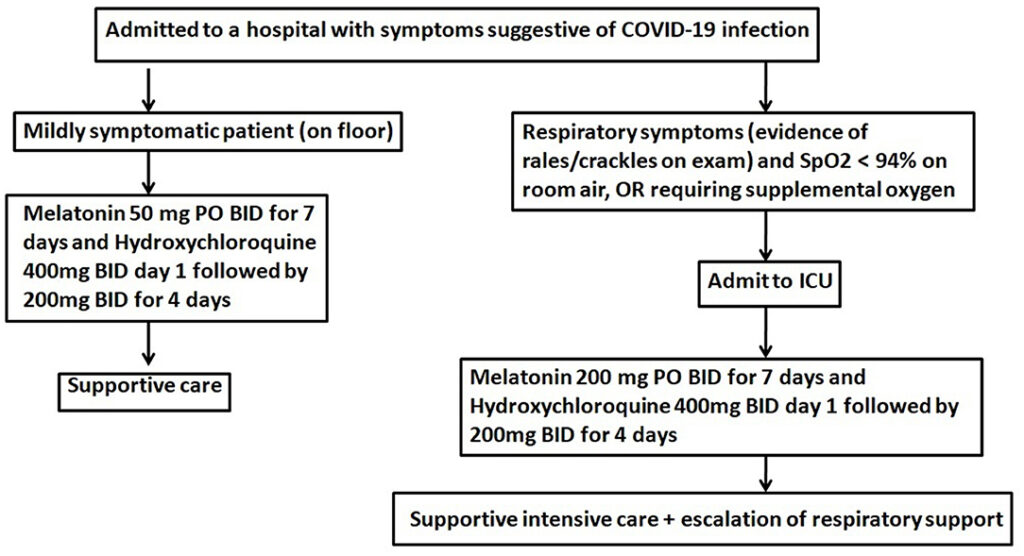
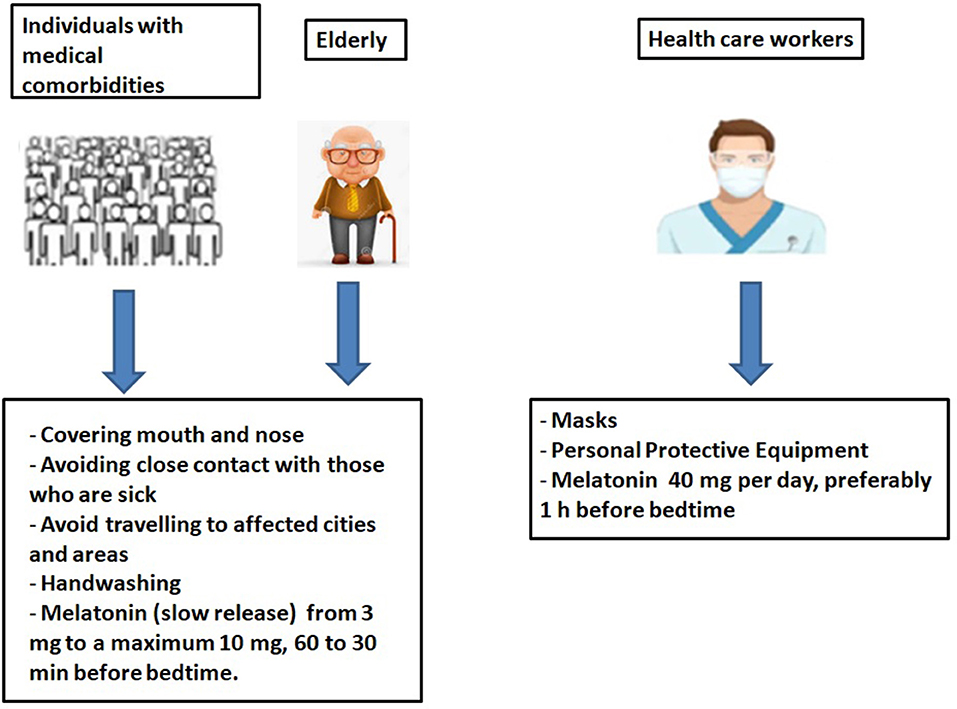
Keep in mind there has been no toxic dosage found in research. It also will not shut down your endogenous production! 100-200mg per day can be taken with most people safely according to many experts!
Melatonin seems to have a protection for those in acute and chronic stress! This really describes most of us in todays world! Melatonin protects against the immunosuppressive effect of acute stress!
Melatonin. is critical in promoting immune function as research clearly shows. This is especially true for v. immunity. One challenge is absorption orally! Studies show bioavailability of oral melatonin is only 3 %! Ref Melatonin is NO available in any IV or injection form commercially so it only leaves limited options! Could suppository be the best with 85% absorption?
Anti-inflammatory agents
Inflammatory pathways play essential roles in v. infections. Ref Melatonin plays a key role in various biological processes, and offers a potential strategy in the management of v. infections. Ref V. infections are often associated with immune-inflammatory injury, in which the level of oxidative stress increases significantly and leaves negative effects on the function of multiple organsRef. The antioxidant effect of melatonin makes it a putative candidate drug to relieve patients’ clinical symptoms in anti v. treatment, even though melatonin cannot eradicate or even curb the v. replication or transcriptionRef. In addition, the application of melatonin may prolong patients’ survival time, which may provide a chance for patients’ immune systems to recover and eventually eradicate the v. As shown in Fig. 5e, melatonin indirectly targets several HCoV cellular targets, including ACE2, BCL2L1, JUN, and IKBKB.
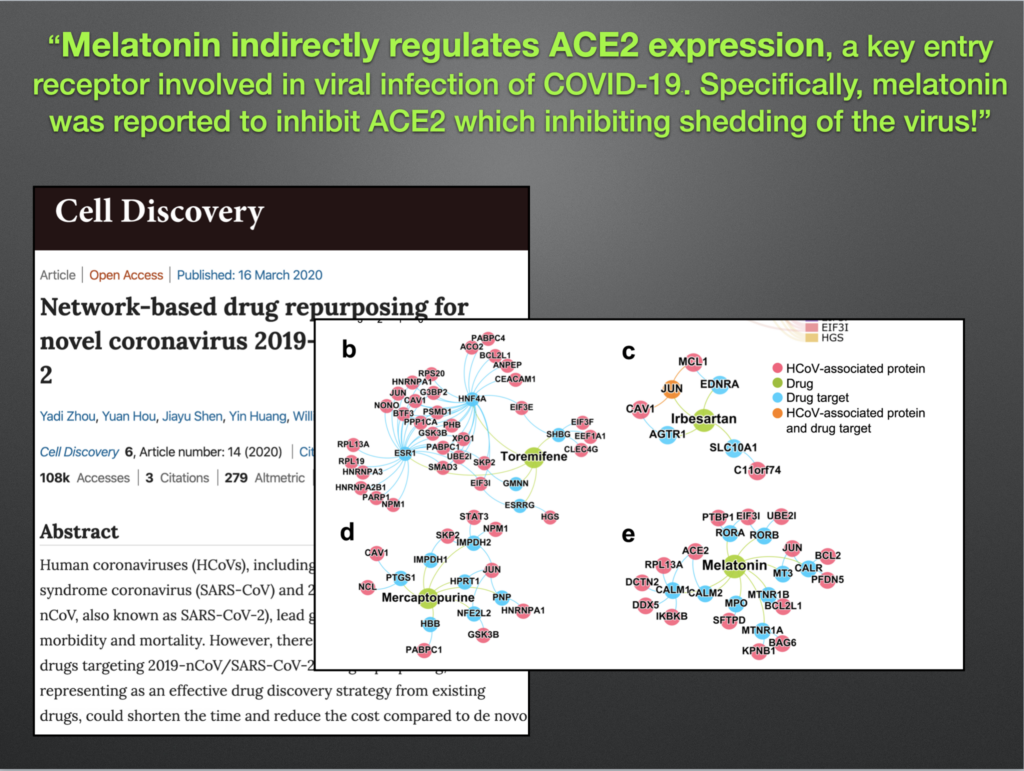
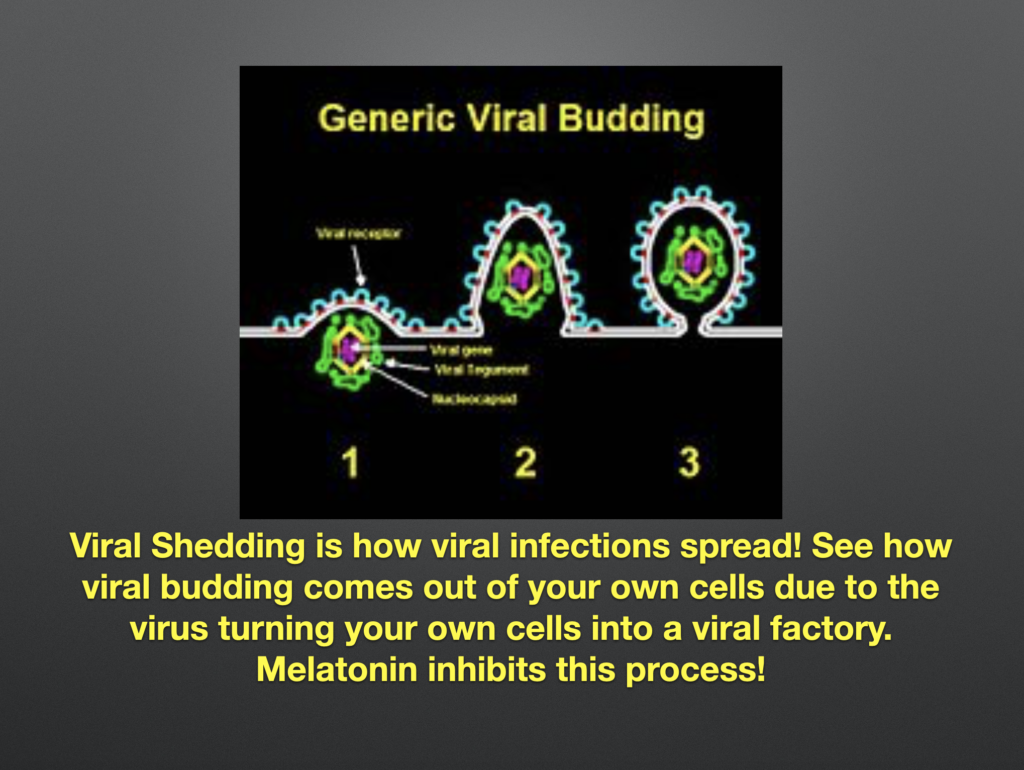
Below are several articles on how Melatonin can support the immune system. For a deep dive into this subject please read them! Glutathione is another interesting nutrient for immunity. See my article on Glutathione here. Also see my article on high dose Vit D here. Also Sinus health is extremely improtant!
IF you are taking ACE inhibitors, have cardiac conditions, hypertension, you need to consult your physician before taking high doses of melatonin. Melatonin may lower blood pressure and cause hypotension at higher dosages.
- P. Lissoni, S. Barni, G. Cattaneo, C. Archili, F. Rovelli, R. Rescaldani, F. Brivio, F. Pellizzoni, D. Esposti, G. Demartini, F. Scaglione and F. Fraschini, Pineal-Interleukin-2 Interactions and their Possible Importance in the Pathogenesis of Immune Dysfunctions in Cancer, Role of Melatonin and Pineal Peptides in Neuroimmunomodulation, 10.1007/978-1-4615-3756-4_31, (273-279), (1991).Crossref
- Claudio Pioli, M.Cristina Caroleo, Giuseppe Nistico' and Gino Doriac, Melatonin increases antigen presentation and amplifies specific and non specific signals for T-cell proliferation, International Journal of Immunopharmacology, 10.1016/0192-0561(93)90060-C, 15, 4, (463-468), (1993).Crossref
- Georges J.M. Maestroni and Ario Conti, Beta-endorphin and dynorphin mimic the circadian immunoenhancing and anti-stress effects of melatonin, International Journal of Immunopharmacology, 10.1016/0192-0561(89)90078-7, 11, 4, (333-340), (1989).Crossref
- Daniel P. Cardinali, Ana I. Esquifino, Georges J.M. Maestroni and Seithikurippu R. Pandi-Perumal, Circadian Organization of the Immune Response, Neuroimmunology of Sleep, 10.1007/978-0-387-69146-6_3, (59-84), (2007).Crossref
- Ana I. Esquifino, S.R. Pandi-Perumal and Daniel P. Cardinali, Circadian organization of the immune response: A role for melatonin, Clinical and Applied Immunology Reviews, 10.1016/j.cair.2004.08.002, 4, 6, (423-433), (2004).Crossref
- Hala A Awney, Ahmed M Attih, Sami L Habib and Mostafa H Mostafa, Effect of melatonin on the production of microsomal hydrogen peroxide and cytochrome P-450 content in rat treated with aflatoxin B1, Toxicology, 10.1016/S0300-483X(01)00545-5, 172, 2, (143-148), (2002).Crossref
- Erhard Haus and Michael H. Smolensky, Biologic Rhythms in the Immune System, Chronobiology International, 10.3109/07420529908998730, 16, 5, (581-622), (2009).Crossref
- Deepta Atre and Elliott J Blumenthal, Melatonin: immune modulation of spleen cells in young, middle-aged and senescent mice, Mechanisms of Ageing and Development, 10.1016/S0047-6374(98)00046-3, 103, 3, (255-268), (1998).Crossref
- Mohammad A. Pahlavani, Intervention in the aging immune system: Influence of dietary restriction, dehydroepiandrosterone, melatonin, and exercise, AGE, 10.1007/s11357-998-0025-5, 21, 4, (153-173), (1998).Crossref
- D. Ben-Nathan, G. J. M. Maestroni, S. Lustig and A. Conti, Protective effects of melatonin in mice infected with encephalitis viruses, Archives of Virology, 10.1007/BF01309858, 140, 2, (223-230), (1995).Crossref
- José Ramón Vielma, Ernesto Bonilla, Leonor Chacín-Bonilla, Marylú Mora, Shirley Medina-Leendertz and Yanauri Bravo, Effects of melatonin on oxidative stress, and resistance to bacterial, parasitic, and viral infections: A review, Acta Tropica, 10.1016/j.actatropica.2014.04.021, 137, (31-38), (2014).Crossref
- Pharmacokinetics of oral and intravenous melatonin in healthy volunteers. Crossref
- Network-based drug repurposing for novel coronavirus 2019-nCoV/SARS-CoV-2 Crossref
- Bertuglia S, Marchiafava PL, Colantuoni A. Melatonin prevents ischemia reperfusion injury in hamster cheek pouch microcirculation. Cardiovasc Res 1996; 31, 947-952. Crossref
- Melatonin protects lung mitochondria from aging | SpringerLink https://link.springer.com/article/10.1007%2Fs11357-011-9267-8
- Same Molecule but Different Expression: Aging and Sepsis Trigger NLRP3 Inflammasome Activation, a Target of Melatonin – PubMed CrossRef
- Melatonin Alleviates Acute Lung Injury Through Inhibiting the NLRP3 Inflammasome – PubMed CrossRef
